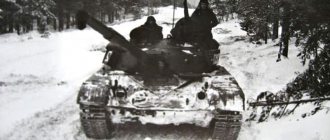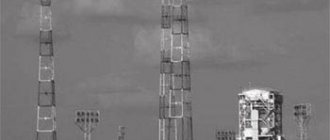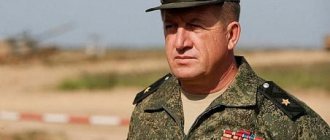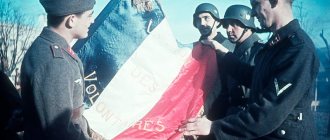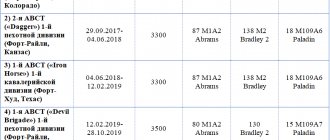The location of military unit 19612 or one of the most famous military formations in Russia - the 4th Guards Order of Lenin Red Banner Kantemirovskaya Tank Division named after Yu. Andropov is located in the city of Naro-Fominsk, Moscow region. The unit belongs to the Western Military District.
Let's take a closer look at military unit 19612, the history of its creation, the impressions of the soldiers who served there, how to get there and where to stay for relatives of military personnel.
Historical data about the Kantemirovsky division
The Kantemirovskaya division (in common parlance - Kantemirovka) was formed on the basis of an operational-tactical military formation - the 17th Tank Corps, organized at the height of the Second World War in the city of Stalingrad.
In 1943, the corps was awarded the guards rank and the name Kantemirovsky, as a unit that particularly distinguished itself in the battles for the village of Kantemirovka (now the administrative center of the district of the same name in the Voronezh region).
The corps personnel took the Guards oath in combat conditions, on the eve of the offensive operation on the Kursk Bulge. For the heroism shown during the liberation battles of 1944 for the right bank of Ukraine, the unit was awarded one of the highest awards of the USSR - the Order of the Red Banner.
At the beginning of 1945, the tank corps received the Order of Lenin for the liberation of the Polish city of Krakow. During the war years, 32 military personnel of the formation were awarded the highest degree of distinction - the title of Hero of the Soviet Union.
During the post-war restructuring of the USSR Armed Forces, the corps was reorganized into the 4th Guards Tank Division as part of the Moscow Military District with a permanent location in Naro-Fominsk near Moscow. In 1946, for the first time, guardsmen paraded military vehicles along the capital's Red Square in honor of the officially established holiday - Tankman's Day.
June 26, 1942, the 17th Tank Corps was created on the banks of the Don, west of Voronezh. The tank unit received its first baptism of fire during heavy fighting during the liberation of the village of Kantemirovka, in honor of which it received it in 1946 by order of I.V. Stalin's name was "Kantemirovskaya Division".
On January 3, 1943, the 17th Tank Corps was transformed into the 4th Guards Tank Corps, in 1945 it was reorganized into the 4th Guards Tank Order of Lenin, Red Banner Kantemirovsky Division, which became one of the founders of the Russian tank forces.
On July 31, 1943 , on the eve of the August offensive and stubborn battles in the Belgorod-Kharkov direction of the Kursk Bulge, when presenting the Guards Banner to the corps, the personnel of the formation took their first Guards oath.
T-34-76 tanks support the infantry attack on the Kursk Bulge.
Tankers of the 17th Guards Tank Brigade and the son of the regiment on a T-34-85 tank.
The crew of the KV-1 heavy tank under the command of Lieutenant N. Kinder (far right) from the 17th Tank Brigade at their combat vehicle. Two weeks after this photo, the entire crew was killed in action.
The 4th Guards Tank Corps took part in military operations in the Donbass, on the Kursk Bulge, crossed the Dnieper, fought for Zhitomir, Shepetovka, Tarnopol, Lvov, and defeated German troops in Poland, Germany and Czechoslovakia.
For the courage and heroism shown during the liberation of a number of cities on the right bank of Ukraine - Zbarazh, Tarnopol, Shepetivka - in April 1944, the corps was awarded the Order of the Red Banner, and regiments and individual battalions earned 17 honorary names: Shepetovsky, Zhitomirsky, Yampolsky, Tarnopolsky.
Corps units liberated Krakow and Prague, were among the first to join the allies on the Elbe, and fought stubborn battles near Dresden. Having made a swift raid into Czechoslovakia, the corps honorably completed its combat journey in the area of the village of Melnik, located north of Prague, this happened on May 11, 1945 .
For the liberation of Krakow, the corps was awarded the Order of Lenin.
The Kantemirovites traveled 4 thousand kilometers from Voronezh and the Don to Prague and the Elbe. During the Great Patriotic War, Supreme Commander-in-Chief I.V. Stalin expressed gratitude to the personnel of this tank corps for their excellent actions as many as 18 times, and Moscow saluted the Kantemirov soldiers in honor of the victories they achieved.
Thirty-two soldiers of the formation received the title of Hero of the Soviet Union (5 of them were forever included in the lists of division units), six soldiers became full holders of the Order of Glory, more than 21 thousand soldiers and commanders were awarded various orders and medals.
On June 14, 1945, the corps, in connection with demobilization, was transformed into the 4th Guards Kantemirovsky Division. The unit became part of the troops of the Moscow District with a deployment in the city of Naro-Fominsk.
On July 11, 1946, in commemoration of the outstanding merits of tank formations in the Great Patriotic War, Tankman Day was established, which is celebrated on the second Sunday of September.
On September 8, 1946 , in Moscow on Red Square, in accordance with the order of the Minister of the Armed Forces of the USSR, a parade march of the 4th Guards Kantemirovskaya Tank Division was held. This was the first and only time when an entire tank division took part in the parade in the center of Moscow. Almost a thousand armored fighting vehicles took part in the parade, which lasted more than three hours, which is more than the number of Soviet tanks that took part in the battle of Prokhorovka. This parade became the first official celebration of Tankman Day in our country. It is a high honor to march at the ancient walls of the Moscow Kremlin by special decree of I.V. Stalin was awarded to the soldiers of the famous 4th Guards Tank Kantemirovsky Division.
On February 23, 1984, the division was named after Yu.V. Andropova.
Military personnel of the formation took part in peacekeeping operations in South Ossetia in 1997, in Kosovo in 1998-2002, and in the counter-terrorism operation in the Chechen Republic.
Kantemirovskaya Street and the Kantemirovskaya metro station in Moscow are named in honor of the division.
During the military reform in 2009, the 4th Guards Kantemirovskaya Tank Division was reorganized into the 4th Separate Tank Brigade.
In May 2013, by decision of the Minister of Defense of the Russian Federation S.K. Shoigu, 4th Guards Tank Kantemirovskaya Order of Lenin, Red Banner Division named after Yu.V. Andropova was reinstated. The division's parade squad took part in the Parade on May 9, 2013 under its historical name.
Today, the Kantemirovskaya division is a powerful formation that includes tank and motorized rifle regiments, artillery and military air defense units, as well as combat, logistics and technical support.
Square with three tanks near the checkpoint of the Kantemirovskaya division
Modern Kantemirovka
In the 90s, Kantemirov guardsmen took part in peacekeeping and counter-terrorism operations in Kosovo and the North Caucasus. During the Russian army reform of 2008-2009, the tank unit was reorganized into a brigade. The revival of Kantemirovka as a division took place in 2013 by decision of the Ministry of Defense.
From this period, the latest models of military equipment began to enter service with the units. Since 2016, the Kantemirovites have become part of the operational military formation of the Armed Forces of the Russian Federation - the First Guards Tank Army.
The division includes several main tactical units:
| Departments with numbers | Conventional digital names of military units |
| guards regiments | |
| 12th Panzer | 31985 |
| 13th Panzer | 32010 |
| 423rd Motorized Rifle | 91701 |
| 275th self-propelled artillery | 73941 |
| 538th Anti-Aircraft Missile | 51383 |
| guards battalions | |
| 413th connection | 56132 |
| 330th Combat Engineer | 80808 |
| 165th Medical | 57069 |
| 137th separate reconnaissance battalion 54919 | |
| 1088th separate logistics battalion 56164 | |
| separate companies | |
| curfew | |
| evacuation | |
| electronic warfare | |
| RCBZ | |
| unmanned aerial vehicles | |
The position of division commander since 2022 has been occupied by Guard Colonel V.V. Zavadsky. On May 9, soldiers and officers of Kantemirovka take part in the annual Victory Parade, held on Red Square in the capital of the Russian Federation.
At the division headquarters, the Red Banner of the Second World War and the modern St. George Banner, received during the revival of the formation in 2013, are carefully preserved. On the territory of the military unit there are barracks and service facilities: a parade ground, a barracks, a guardhouse, a sanitary unit, a canteen, a club, training facilities, a snack bar (chipok).
Parking, technical and warehouse area: a park of military equipment and weapons, workshops, a fuel and lubricants warehouse, a chemical warehouse, an engineering warehouse, a communications warehouse, a food and clothing warehouse, a utility service warehouse.
Field training of Kantemirovka soldiers and officers takes place at a military training ground in the Moscow region. The territory of the Golovenki training ground is fully equipped for testing various types of weapons and military equipment, practicing combat situations, training and training personnel.
Additionally
The formation has its own Museum of Military Glory. Most exhibitions are dedicated to the events of the Second World War. Among the exhibits are awards and award certificates of battle participants, their personal belongings, uniforms, weapons, and letters from the front. In total there are more than 3.5 thousand copies.
In 2022, the museum officially opened after restoration. The annual traffic of the divisional museum exceeds 10 thousand people.
In 1997, the Alexander Nevsky Chapel was built on the territory of the military unit and is functioning today. The temple belongs to the Moscow Patriarchate of the Russian Orthodox Church. Every year in June an “Open Day” is held in Kantemirovka, dedicated to the division’s birthday.
Festive events include awards for distinguished military personnel, technical demonstrations, meetings with WWII veterans, concerts of popular performers, and tasting of field cuisine for everyone. In 2022, the guards solemnly celebrated the seventy-fifth anniversary of the founding of the military formation.
4th Guards Tank Division
The Second World War
The direct ancestor of the 4th Guards Kantemirovskaya Tank Division was the Red Army's 17th Tank Corps, originally formed at Stalingrad in 1942 shortly after the start of the German invasion of the Soviet Union during World War II. The 17th Tank Corps began its combat activity on June 26, 1942, when it was deployed west of Voronezh, shortly before the Battle of Voronezh (1942). For distinction in battle during Operation Little Saturn between December 17 and December 30, 1942, the 17th Tank Corps was redesignated as the 4th Guards Tank Corps in January 1943. [9] The corps received the honorific Kantemirovsky
after the village of Kantemirovka in the Kantemirovsky district, Voronezh region, when she liberated it from German troops with tank units as a baptism of fire.
In August 1943, the 4th Guards Tank Corps withstood continuous battle in the Belgorod-Kharkov direction of Kursk. For the courage and heroism shown during the liberation of the cities of Right Bank Ukraine, including Zbarazh, Ternopil and Shepetivka in April 1944, the corps was awarded the Order of the Red Banner. Seventeen regiments and individual battalions were awarded certificates of honor from Shepetovsky
,
Zhitomir
,
Yampol
and
Tarnopol
in honor of the cities they took.
The corps took part in the battles for Krakow, for which it was awarded the Order of Lenin.
The 4th Guards Tank Corps was one of the first formations of the Red Army to reach the Elbe and took part in the capture of Dresden in Germany. The corps was suddenly redeployed to Czechoslovakia, where they saw their last battles of the war in the suburbs of Prague during the Prague Offensive. For the courage shown by the soldiers and officers of the Corps in wartime, military units were awarded 23 awards, the personnel of the Corps were officially commended by the Supreme Commander-in-Chief 18 times, 32 of its members were awarded the title of Hero of the Soviet Union (5 of which are forever credited in single rolls) More than 20,000 soldiers received decorations and medals, five becoming full Chevaliers in the Order of Glory.
On June 14, 1945, the 4th Guards Tank Corps became the 4th Guards " Kantemirovskaya"
"tank division
, and on September 13, 1945 it was transferred to the troops of the Moscow Military District with a relocation to Naro-Fominsk, where its garrison remained. since then.
Cold War period
In the fall of 1946, the division took part in the Tankmen's Day Parade on Red Square in Moscow. [10] [11] On May 23, 1953, the division's 3rd Guards Motorized Rifle Regiment became the 119th Guards Mechanized Regiment. The 275th Guards Artillery Division was formed from the 264th Guards Mortar Regiment and a howitzer artillery battalion. The 76th separate motorcycle battalion was converted into a reconnaissance battalion. In April 1955, the 120th Guards Anti-Aircraft Artillery Regiment became the 538th Guards Anti-Aircraft Artillery Regiment. In June 1957, the 14th Guards Tank Regiment was disbanded. At the same time, the 43rd Guards Heavy Tank Self-Propelled Regiment became the 43rd Guards. The heavy tank regiment and the 119th Guards Mechanized Regiment were transformed into the 423rd Guards Motorized Rifle Regiment. [12]
In 1960, the division's training tank battalion was disbanded. At the beginning of 1962, the 43rd Guards Heavy Tank Regiment became a regular tank regiment. On February 19 of the same year, the 196th Separate Maintenance and Reconstruction Battalion and the 339th Separate Missile Battalion were activated. In 1968, the 106th separate engineer battalion became the 330th separate engineer battalion. In 1972, the independent chemical defense company became the 616th independent chemical defense battalion. In 1980, the motor transport battalion was renamed the 1088th separate logistics battalion [12].
On February 23, 1984, the division received an honorary name "in the name of Yuri Andropov", the then Secretary General of the USSR. In 1989, the 43rd Guards Tank Regiment was replaced by the 14th Guards Tank Regiment. During the Cold War, the division's strength was 80%. [12]
The division was one of two main divisions deployed to Moscow in August 1991 as part of an attempted hard coup against Soviet President Mikhail Gorbachev. The failure of the coup strengthened Boris Yeltsin's position in the Russian SFSR, and soon after in the Russian Federation, of which he became president.
Russian Federation
T-80 of the 4th Tank Division during exercises.
Soldier of the CBRN company of the 4th Guards Kantemirovskaya Tank Division.
After the collapse of the Soviet Union in December 1991, the 4th Guards Tank Division became part of the Russian Ground Forces, the Ground Forces of the Russian Federation. During the most serious crisis of Yeltsin's premiership, the 1993 constitutional crisis, the Branch was one of several key units that reluctantly supported Yeltsin by October 4, the decisive moment of the crisis. In the early 1990s, the division became part of the famous 1st Guards Tank Army along with the 144th Guards Motorized Rifle Division. The first GTA was deployed from former East Germany to Smolensk when the Group of Soviet Forces in Germany was disbanded in the early 1990s; it was disbanded in 1998, as was the 144th MRD. After this, the Kantemirovskaya division came under the command of the 20th Guards Army.
Units of the division participated in the First Chechen War, and then personnel participated in peacekeeping operations in South Ossetia in 1997, in Kosovo in 1998–2002, and then in the Second Chechen War. [13]
During this period, it was one of the "constant readiness" divisions of the Russian Army, with at least 80% of its personnel and 100% of its equipment available at all times.
On May 9, 2005, eight T-80BV tanks of the division took part in a parade in Moscow dedicated to the 60th anniversary of Victory Day. On December 27, 2005, the Department was visited by Sergei Ivanov, with the Minister of Defense of the Russian Federation. At the beginning of 2006, the division's 13th Tank Regiment, along with other units of the 20th Guards Army, participated in the joint Russian-Belarusian Union Shield exercise.
Kantemirovskaya Street in Moscow is named after the 4th Guards Tank Division. [13]
In 2009, the Russian Ministry of Defense announced that the division would be reorganized into two brigades, which would retain their insignia and awards. [ citation needed
] Later that year the division was reduced to the 4th Separate Guards Tank Brigade, which was still stationed at Naro-Fominsk. [13] In May 2013, the Kantemirovskaya division was reorganized from a tank brigade. [14]
As of June 2015, within 2 years of the division's re-establishment, the Russian Armed Forces are planning to re-establish the famous Soviet-era 1st Guards Red Banner Tank Army, to include the 4th Guards Tank Division and the 2nd Guards Motorized Rifle Division, as well as one tank rifle brigade (from the 1990s until its disbandment in 1998, the army included the 4th Guards TD). [15]
Main types of weapons of Kantemirovka
The purpose of a tank division during combat operations is to provide fire support to motorized rifle units during defense and to break through defenses during an offensive. Tanks are used to deliver powerful and deep strikes on the main combat axes.
In the 90s, the division was armed with various types of military equipment:
- battle tanks T-80, T-64, T-72;
- tracked infantry fighting vehicles BMP-1, BMP-2;
- self-propelled howitzers 2S1 “Gvozdika”;
- armored personnel carriers BTR-70;
- mobile reconnaissance points PRP-3 and PRP-4.
Today, Kantemirov soldiers (conscripts and contract soldiers) serve with modern military equipment. At the Kantemirovka base, tests of the latest technology, modern communications equipment, weapons, personal protective equipment and personnel equipment are carried out. Guards tank crews regularly take part in the most spectacular competition of the International Army Games - tank biathlon.
Conditions of service in division units
Division personnel undergoing military service are housed in cubicle-type barracks (4-6 people each) or standard barracks with several rooms:
- bedrooms;
- consumer services room (CBO);
- mini-gym;
- bathroom, washroom, showers;
- room for drying uniforms;
- leisure room.
The daily routine for conscript soldiers in Kantemirovka does not differ from the standard regimen adopted in the Armed Forces:
- wake-up – at 6:00;
- Charging – until 6:30.
This is followed by the procedures of washing, making beds, and morning examination.
- breakfast – from 7:30 to 8:00;
- morning formation - until 9:00.
Before lunch, the soldiers are given drill and physical training classes every day - about four hours. The venue is the divisional parade ground, sports ground. Much attention is paid to the study of the Charter of the Armed Forces (Disciplinary, Garrison and Guard Service, Combat, Internal Service Charter).
Classes take place in equipped classrooms. Lunch – from 14:20 to 15:00. After lunch, there is an hour's rest, then theoretical classes on combat training, sports events, and educational work are held. Dinner – 19:00. After the evening meal, the fighters are given free time.
Organized viewing of a television news program – 21:00. There is a half-hour walk before lights out. Next, hygiene procedures and evening formation are carried out. Lights out – 22:00. On Saturday, curfew is shifted by 1 hour; on Sunday, wake-up time is at 7:00.
The division's civilian personnel prepare food for the personnel. The dining room is equipped with modern equipment and utensils. During field trips, military personnel are provided with a modern IRP (individual food ration).
Cell phones of personnel are kept by company commanders. For telephone communication with relatives, the time allocated is regulated from 19.00 to 21.00 on weekdays, and in personal time on weekends. The military personnel's allowance is transferred to a Sberbank card, with the possibility of replenishing the account by relatives.
Recruits and oath
Before taking the Ceremonial Oath of Allegiance to the Fatherland, in all military units, recruits undergo the KMB (Young Soldier Course). In Kantemirovka, additional testing is carried out based on the results of the CMB, with the aim of correctly differentiating young soldiers for further training in the military specialties of operator-gunner and driver-mechanic.
The course for a young fighter includes physical, drill, special fire training and the study of army regulations. Particular attention is paid to strict adherence to the daily routine, duties and subtleties of army life.
During the period of completion of the CMB (from 1.5 to 2 months), recruits are placed separately from other military personnel, which helps prevent hazing in units.
On the day of the oath, relatives and friends come to visit the future guardsmen. The command will notify you in advance of the time and date of the event. The ceremony is held on the parade ground in front of the Kantemirovka Battle Banners and the State Flag of the Russian Federation.
After taking the Ceremonial Oath, the Kantemirov commander congratulates the military personnel and guests of the celebration on the holiday. Next, the floor is given to veterans of the Second World War and local wars or representatives of the city district authorities. The ceremony ends with a parade march of the military unit, accompanied by an orchestra.
At the end of the event, recruits are given a leave of absence for several hours. Relatives or guardians of the newly minted soldier must leave a passport in place of a dismissal note - a document signed by the responsible officer about the opportunity to leave the military unit before a certain hour.
Parents and other relatives should remember that for being late from discharge and consuming alcoholic beverages, a serviceman will be punished, up to and including deprivation of leave for the entire period of service. On dismissal, it is allowed to change into civilian clothes brought by relatives.
Comments
- shekstelo Stanislav 05/11/2015, 09:49
served in “kantemirovka” in 1975-1976, came there after training 07008 Vladimir. The commander of the regiment of military unit 35758, 13th regiment, was Colonel Tskhai Lev Ivanovich, battalion commander of the 3rd battalion, Mr. Belus, commander of the 7th company, Lieutenant Valery Skakko. I often remember the guys who served with me - the Afanasyevs, the Queens, the Golubevs and many others. Sincerely, Stanislav Shextelo, Art. mechanic platoon driver - Semenov Yuri Anatolievich 01.04.2015, 12:07
Served 1981-1983. In 1981, the commander was Major Zorya, chief of staff Chebotarev. By 1983, everyone had been promoted and became lieutenant colonels. Lieutenant Colonel Chebotarev became commander. Major Lubyanenko became the head. headquarters
- Alexander 22.01.2015, 21:06
I served there
Information for mom
Parcels and letters
- Unit address: 143300, Moscow region, Naro-Fominsk-1, st. Peshekhonova, 5, military unit 19612, full name of the soldier, company number (check with him).
- Post office address: 143300, Moscow region, Naro-Fominsk-1, Marshal Zhukov Street, 11. The office is open from 8.00 to 20.00 from Monday to Friday. On Saturday - from 9.00 to 18.00, and on Sunday - from 9.00 to 14.00.
- There is a post office in the military town at the address 143301, Naro-Fominsk-1, Shibankova Street, 2. In this office, military personnel receive parcels, valuable letters, and money orders.
You can also send parcels to the address of military unit 19612: soldiers, like letters, receive them once a week. It is better to check the list of transfers with the fighter.
Contact phone numbers
- 7 (496-34) 4-40-55 – telephone number of the Kantemirovskaya division;
- 7 (496-34) 4-40-52 – duty unit of the Kantemirovskaya division;
- 7 (496-34) 4-41-29 – hospital attached to the unit;
- 7 (496-34) 4-41-21 – military court of the Naro-Fominsk garrison;
- 7 (496-34) 4-15-91, 7 (496-34) 4-41-29 – military hospital in Naro-Fominsk;
- 7 (496-34) 3-57-26 – post office phone number;
- 73, 7 (962) 9-888-333 – taxi services in Naro-Fominsk.
How to get there
You can get to the Kantemirovskaya Division by several means of transport:
- By bus. From the Yugo-Zapadnaya metro station, take minibus No. 309 to the Nara stop (another name is Moskovskaya Street). From there, transfer to bus No. 7, 8, 9, 23, 23-b, 26, 27, 29 and get to the unit checkpoint. Check the bus schedule and travel times with the driver;
- By train. Several electric trains depart from Kievsky Station, which follow the directions “Nara”, “Kaluga-1”, “Kaluga-2” and “Maloyaroslavets”. The journey will take you 1 hour 30 minutes. From the stop near the station, minibuses No. 15, 16 and 17 depart and go to the stop on the street. Peshekhonov. Military unit 19612 is located a 30-minute walk from a public transport stop.
- By car. From the Moscow Ring Road, take the Kievskoye Highway and drive about 50 km to Naro-Fominsk. 300 meters after the sign, turn left and follow the main road. After passing the railway bridge, turn left towards McDonald's after about 100 meters. From there, go left, drive about 150 meters along the main road and turn left again. Follow the straight line to the area with three tanks. To their left is the checkpoint of the Kantemirovskaya division.
Where to stay
There are several hotels in Naro-Fominsk:
- "Nara." Rooms in the price categories "Economy", "Standard" and "Lux", with a swimming pool on site. The hotel is located near the hotel and from the part. Phone for reservations: 7 (496-34) 3-81-42;
- "Lyra". Economy and Standard rooms for 1, 2, 3 and 4 people, the price of which includes morning coffee. Located near the city center, military unit 19612 is nearby. Phone for reservations: 7 (496-34) 3-54-54.
- "Cascade". The hotel with Economy class rooms is located next to the railway and bus station of Naro-Fominsk. Not far from it there is a restaurant and a shopping center. The room rate includes breakfast. Phone for reservations: 7 (496-34) 4-50-50;
- "On Volodarka". Mini-hotel in the private sector of Naro-Fominsk with rooms for 2, 3 and 4 people, as well as a separate kitchen. Phone number for booking;
- Hotel attached to the unit. The soldier himself can book economy class rooms. Relatives can do this by calling 7 (926) 326-71-50.
Accommodation reservations must be made in advance.
